The Bay Trail Preview: Intel Atom Z3770 Tested
by Anand Lal Shimpi & Brian Klug on September 11, 2013 12:00 PM ESTIn addition to showing Bay Trail running on a Windows 8.x platform, Intel showed us a “pre-beta” version of the platform running Android 4.2.2. I have to emphasize that the build they showed us definitely seemed pre-beta, as there was some instability, but overall the build was good enough to run some tests on and get a feel for. Intel made it clear that they do have a lot more work to do on their Android build before it’s considered close to final quality than the Windows equivalent.
Inside Android we can still see the CPU state table data and how long the cores are sitting in each performance state still, despite this now being managed in-silicon on Bay Trail. In addition Android sees the 2.39 GHz Z3770 boost frequency and reports it. I didn’t see any strange behavior on the device while running tests and watching CPU frequency, if anything the reference design platform stayed at the maximum boost frequency even with four cores plugged in for an impressive amount of time. Of course this is a tablet so there’s more TDP to play around with compared to a phone.
Depending on where you were in the Android UI, there was some definite stutter, but I’m told this is a result of an issue with Dalvik not allocating threads to cores properly that Intel is still tuning, something which you can see plays itself out as well in the AndEBench Java test that runs in Dalvik. The launcher especially had some stutter, but Intel claimed they were aware of it and that final performance in areas like that would be dramatically improved. Regardless of the state of Bay Trail’s Android port, it affords us the opportunity to look at performance through our pretty standard benchmark suite.
On the CPU side for Android we’re still limited to just a few tests that rely on a combination of native code and stuff that runs inside the browser. That means AndEBench, JavaScript benchmarks, and part of Vellamo.
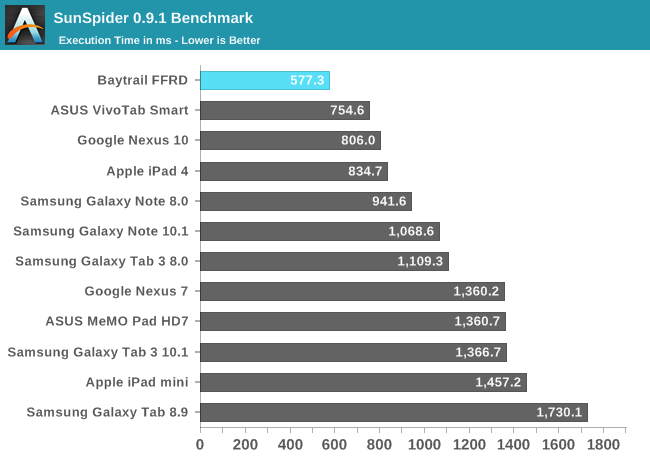
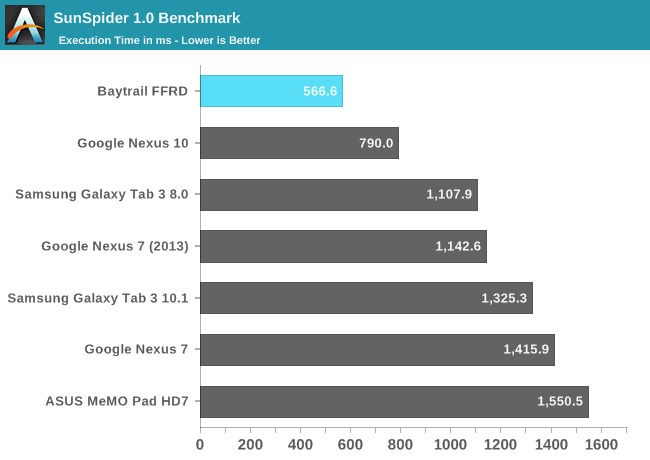
Sunspider has been a regular staple but in recent time has become an exercise in browser JavaScript engine optimization rather than actual performance. Nevertheless the FFRD takes the crown in both 1.0 and 0.9.1 (we have more tablet data from the 0.9.1 version so I replicated it here).
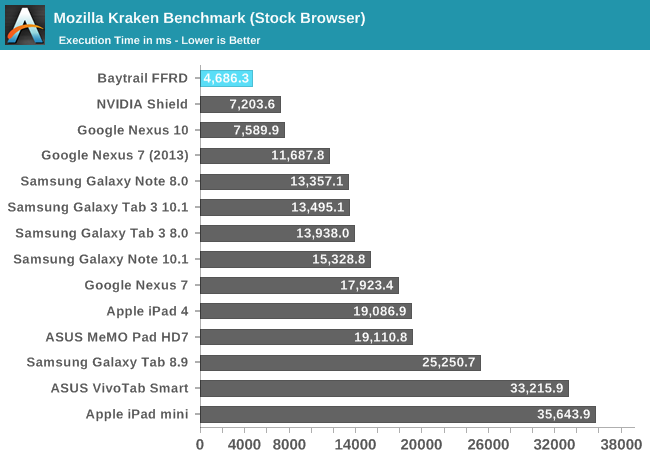
Kraken is another JavaScript benchmark which hasn’t quite been an optimization target everyone has gone after lately, and it’s also longer, which makes it a bit more reliable. Once again Bay Trail takes the crown here with notably faster JS engine performance.
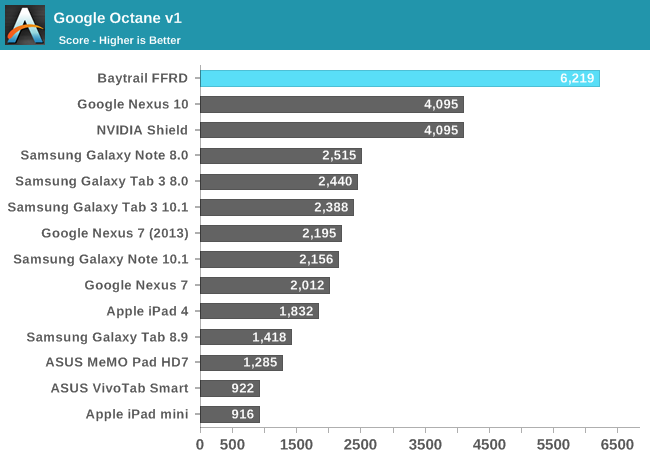
Google Octane is another JS test that isn’t quite as platform optimized yet, here there’s once again dominance by Bay Trail with just over a 50 percent higher score.
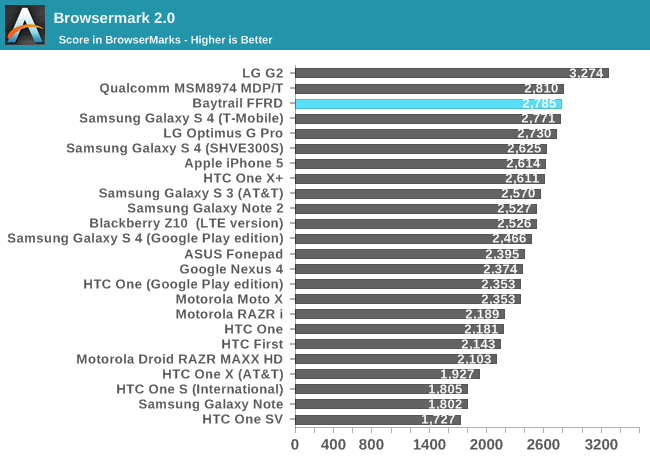
Browsermark has a combination of both JS tests and other web related performance metrics. Here the Bay Trail platform lags behind the 8974 based devices slightly. This isn’t a raw JavaScript benchmark again but rather a more holistic web browsing performance test, so it’s interesting to see Bay Trail a bit behind here.
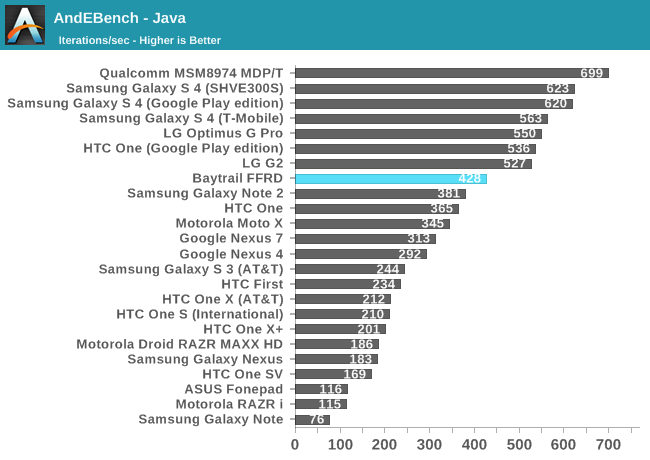

AndEBench is a combination native compiled microkernel benchmark (indicative of NDK application performance) that also runs a very similar workload atop Dalvik like a normal Android Java application. Here we can see what Intel was talking about when they said they have more work to do getting Dalvik working properly at dispatching threads to appropriate cores, hopefully the Java number will climb considerably. The native test also shows a lead over the competition.
GPU Performance
While Bay Trail clearly leads on the CPU side, its GPU performance is more middle of the road - at least among the higher end SoCs. In 3DMark Bay Trail's GPU performance is aided by the more CPU bound nature of the benchmark, but here Intel is able to beat the Snapdragon 600. Snapdragon 800 on the other hand pulls ahead by around 35%.
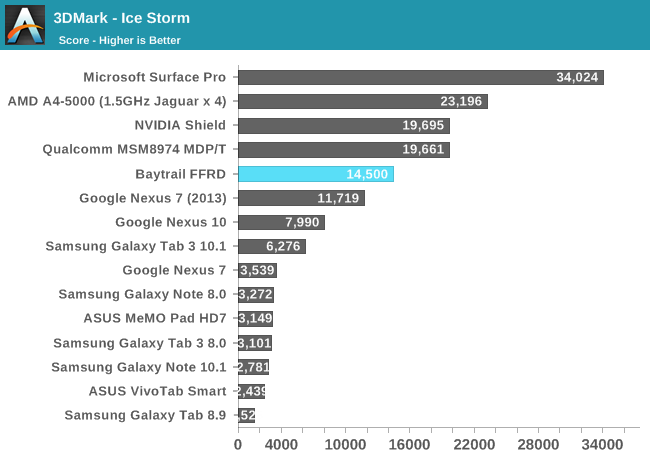
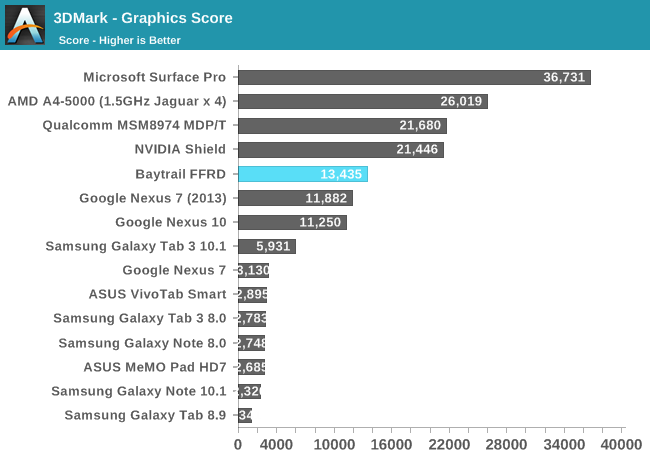
The 3DMark Physics test is effectively a CPU test, which once again plays to Bay Trail's strengths. Here it's faster than Snapdragon 800 and Cortex A15. Only Ivy Bridge is quicker in a tablet.
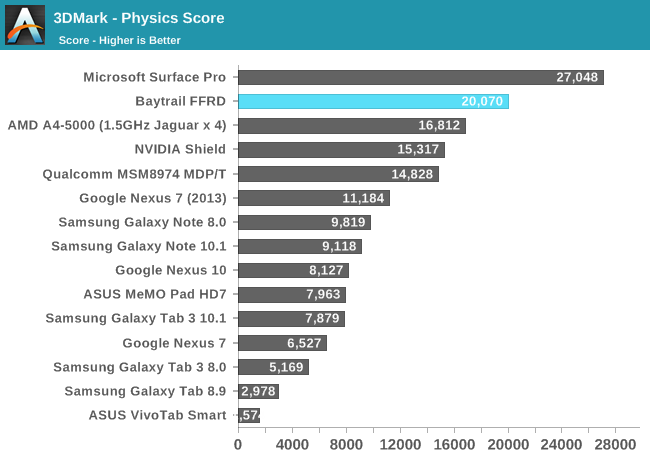
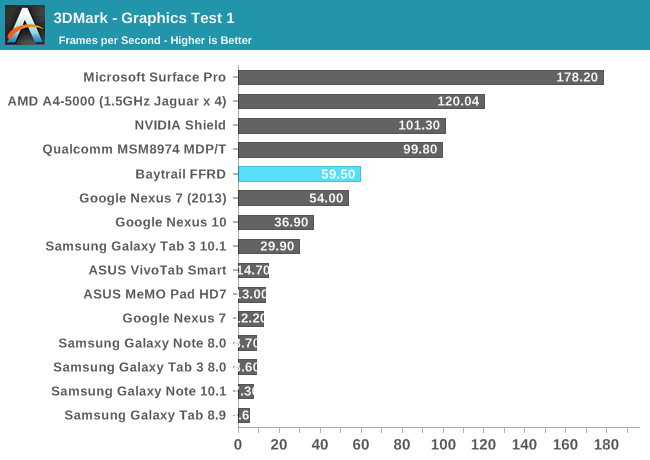
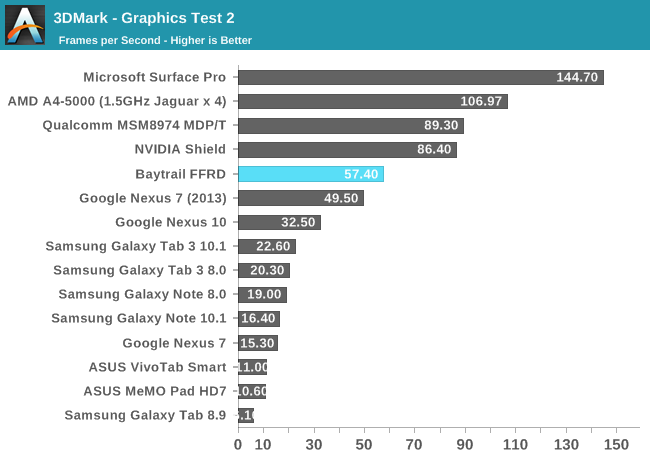
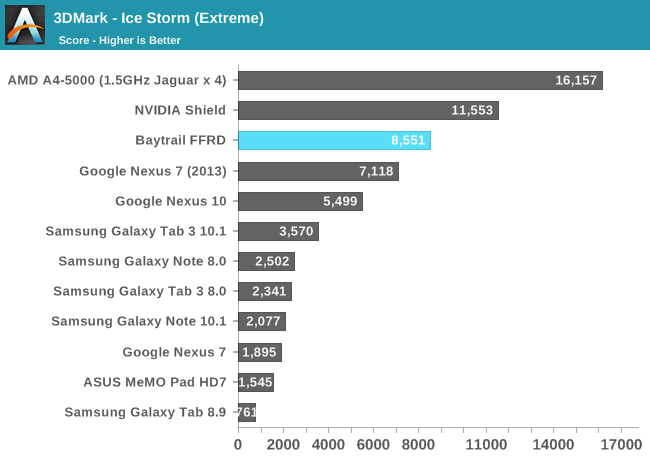
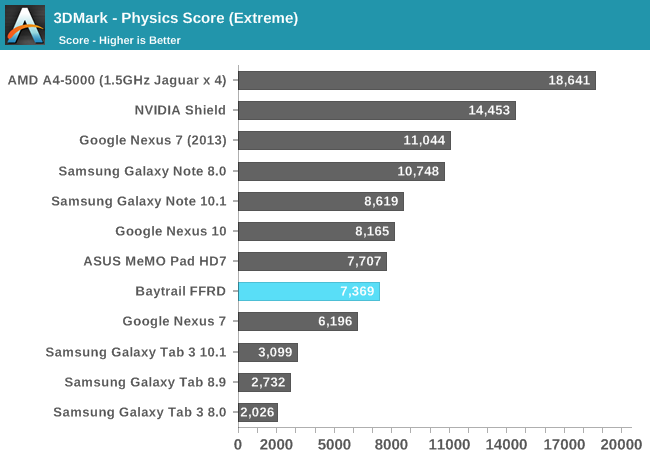
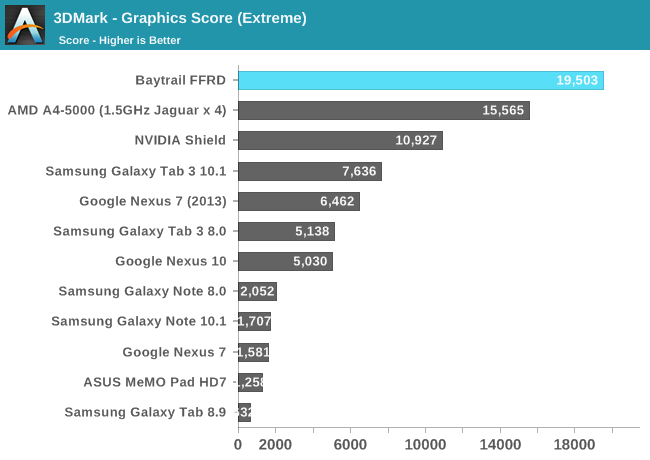
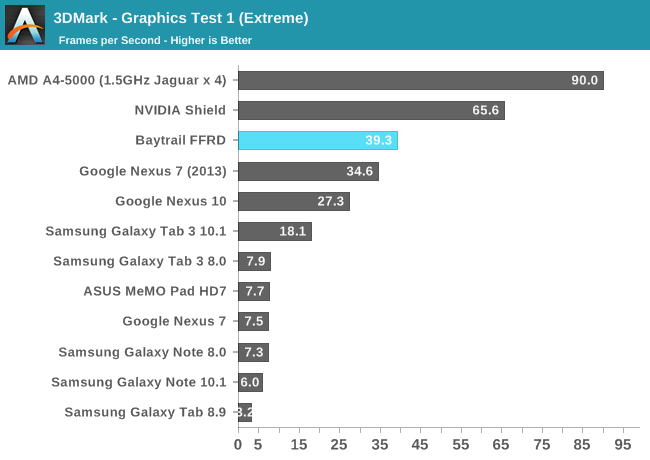
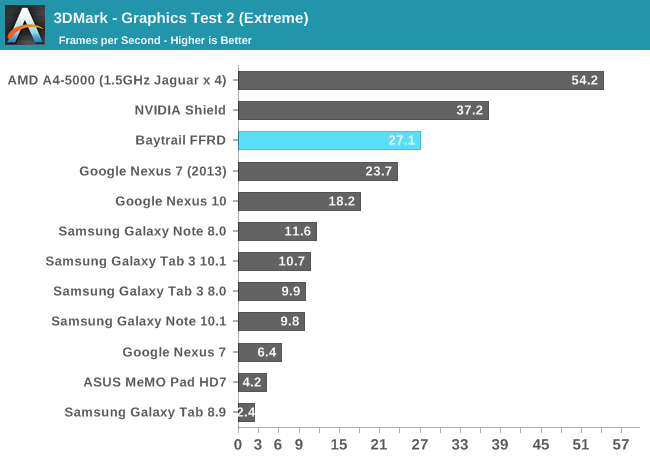
Basemark X
Basemark X is a bit more GPU bound than 3DMark, and we also have iOS data here so we can put Bay Trail's performance in better perspective. Here Bay Trail is a bit slower than the iPad 4, and clearly Tegra 4 and Snapdragon 800. Intel's GPU in Android is measurably quicker than Adreno 320/S600 though.
Bay Trail's onscreen performance is penalized by the FFRD's extremely high native resolution.

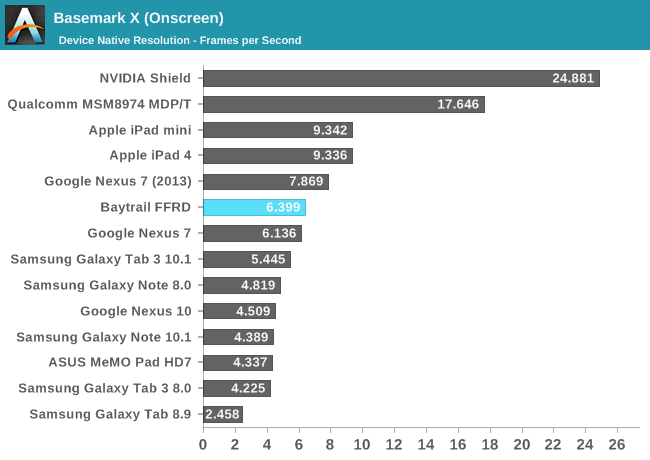
GLBenchmark 2.7
The more interested GLBenchmark numbers, T-Rex HD, show Bay Trail just behind the iPad 4 in performance. It's definitely not bad at all but clearly not industry leading.
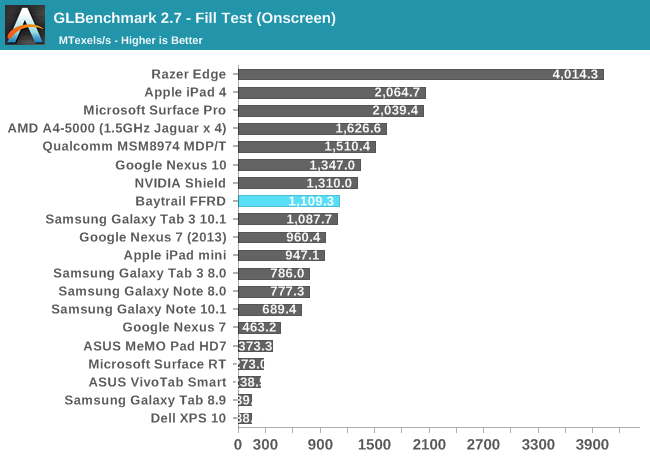
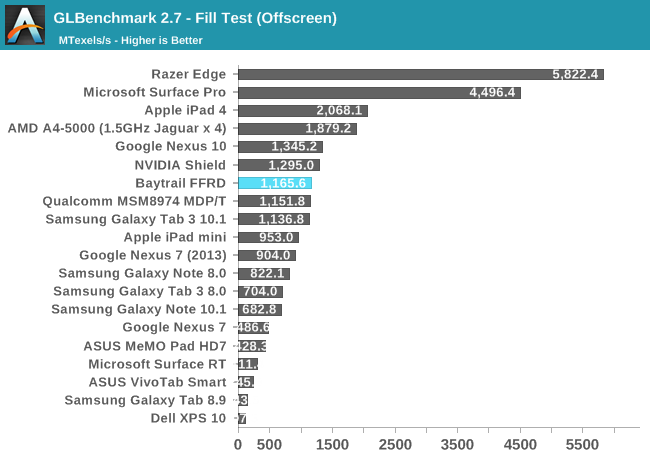
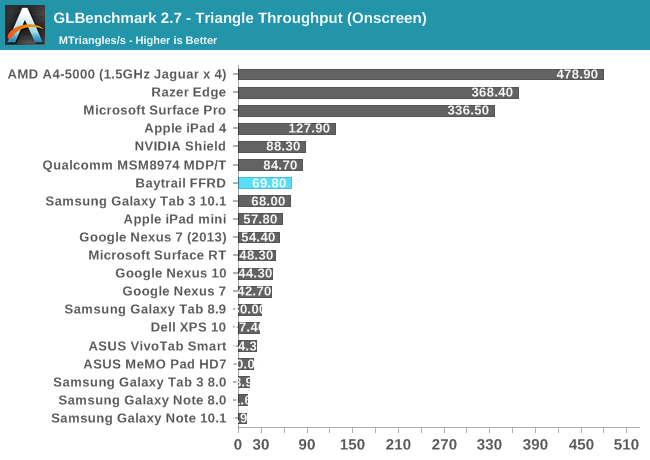
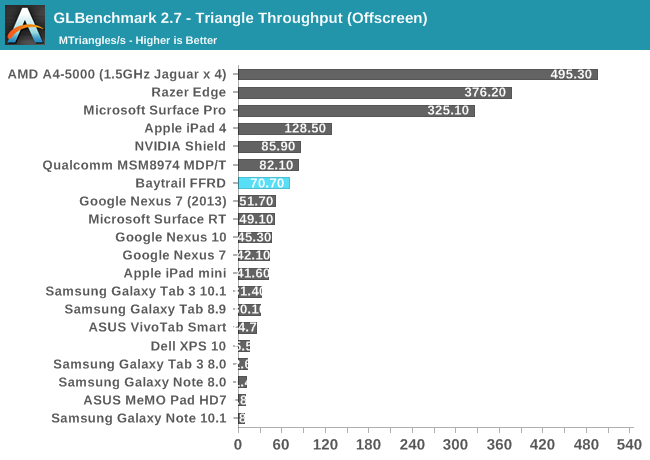
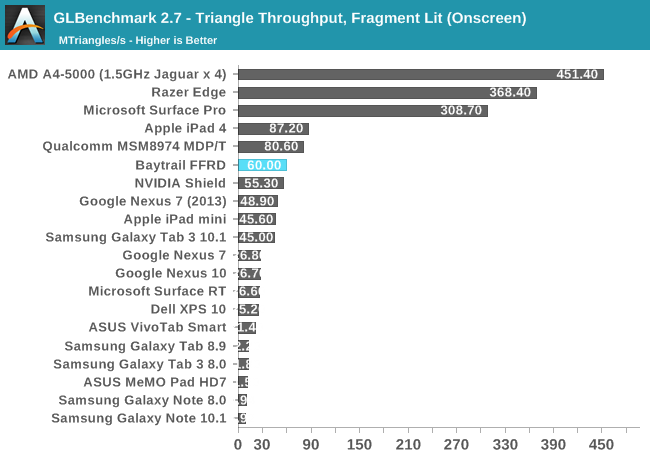
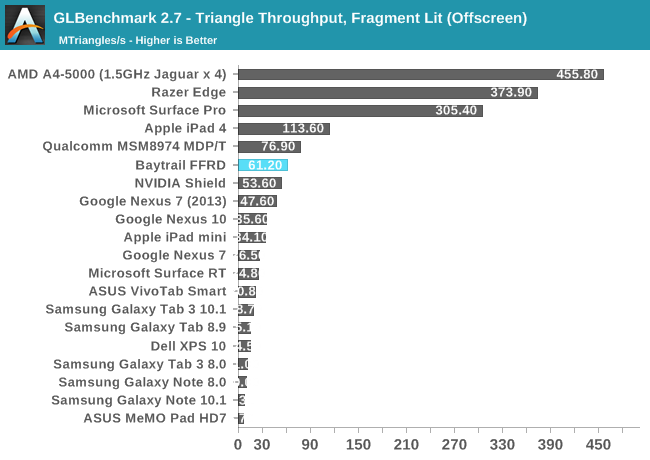
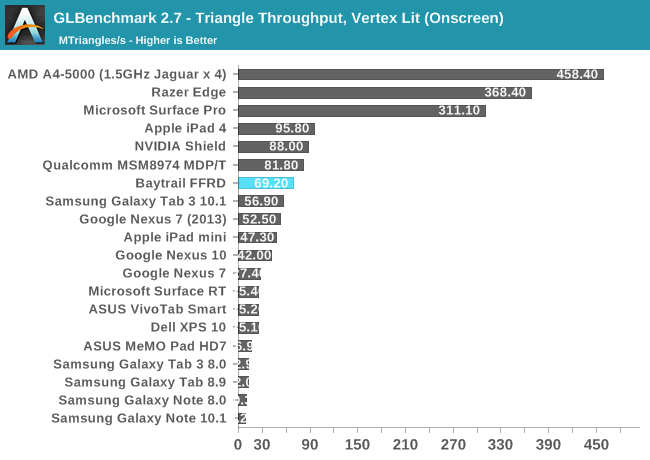
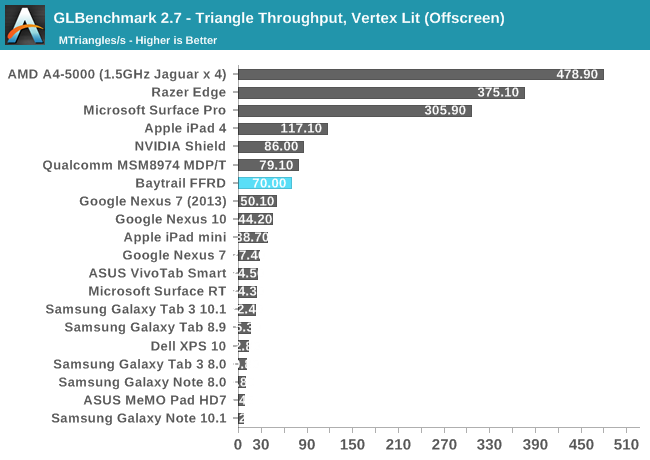
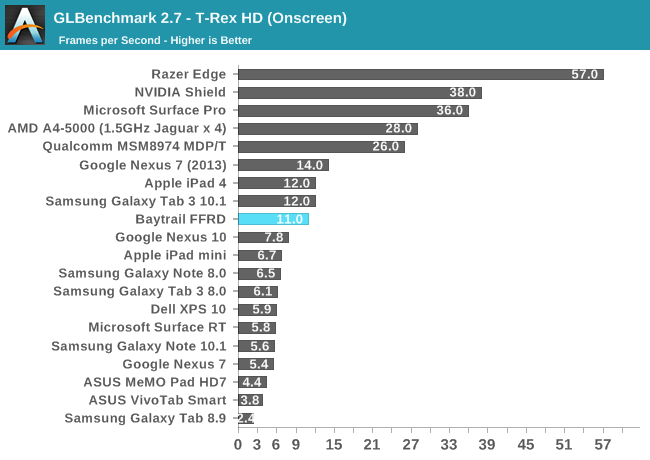
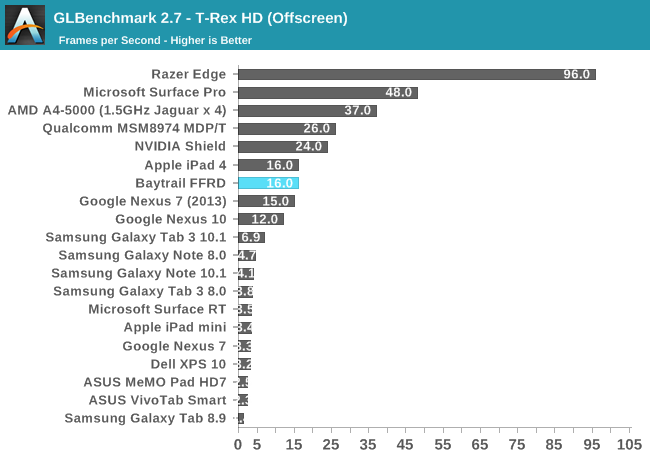
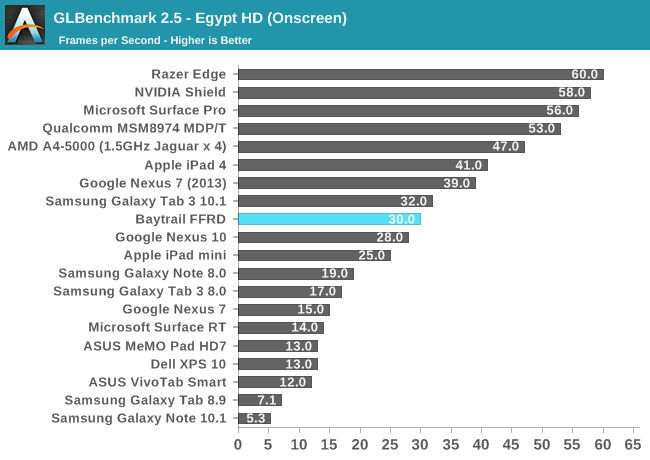
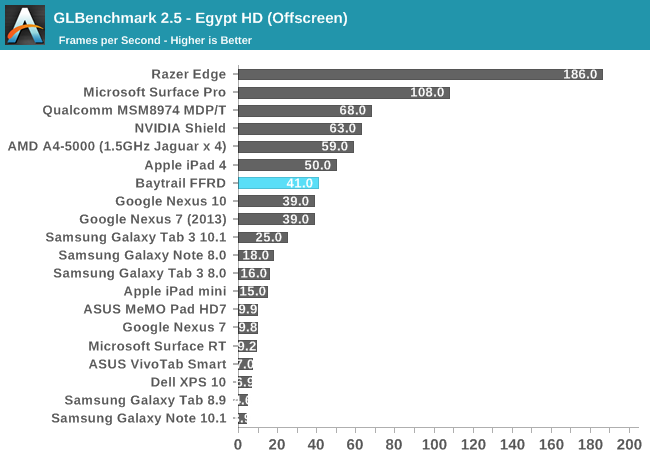
















190 Comments
View All Comments
Homeles - Wednesday, September 11, 2013 - link
I'd wake you up right now, but I'm not sure I'd want to risk you spreading your ignorance to others.zeo - Wednesday, September 11, 2013 - link
Medfield and Clover Trail+ ATOM are already being used in phones and tablets... the direct upgrade is called Merrifield and will be launched early next year but aside from being coupled with a LTE modem it's still based on the same Silvermont Architecture as this Bay Trail model!While Bay Trail is even more energy efficient than the previous Clover Trail ATOM! The Z3770 is providing roughly twice the performance but using no more power than the previous Z2760 Clover Trail, which was a 3W TDP rated SoC...
So battery life would only be worse if they coupled it with energy hogging parts like a 2560x1600 resolution screen for example... The back lighting alone would increase power consumption by up to 30%...
Asus had issues getting good enough battery life for their Tegra 4 updated Infinity Transformer model as well because they used that high resolution screen, for example...
Homeles - Wednesday, September 11, 2013 - link
This is truly incredible. I did not think that Silvermont would outperform Kabini, especially given that Kabini has a much, much higher TDP.It's amazing -- AMD's Jaguar cores have been utterly invalidated. Kabini still has quite the graphics advantage, but at with a power draw several times higher than Bay Trail. This lead will only be exacerbated when Intel's 14nm Airmont drops in next year.
This is truly unbelievable. The question of who will win the ARM war has been answered.
It took 5 years of pain, but it seems like the wait was worth it.
Da W - Wednesday, September 11, 2013 - link
I prefer a Kabini tab all the way. Where did you see such outrageous outperformance? CPU cores are better on some tests, graphics get pounded by AMD it's not even funny.Kabini would give me all the CPU power i need from a tablet, and i prefer more GPU power. Don't really care about power draw, i own a surface pro, anything would be an improvement.
Homeles - Wednesday, September 11, 2013 - link
Fortunately for Intel, and my argument, OEMs DO care about power.Also, just as an FYI, the A4 Kabini chip here is a 15W part. You won't see that in Tablets (or are at least very unlikely to).
icetorch - Wednesday, September 11, 2013 - link
What I'd like to know is if they will compete in the same price range.zeo - Wednesday, September 11, 2013 - link
Bay Trail cost Intel less to make than the previous ATOM, thanks in part to the move to the 22nm FAB... which is much better developed now than when Intel introduced it with Ivy Bridge. So they're pushing for even lower pricing, which at best you might find Temash competing with but not Kabini...Mind, 15W TDP means the need for active cooling and that means larger designs, more materials, etc. that tend to raise costs versus fan-less designs that the Bay Trail T models will go into...
There are already two design wins for 8" tablets that look like they'll be barely priced over $300 and run full Windows 8.1... And they can go cheaper if they release it with Android instead... Never mind the lower end version of Bay Trail... the Z3770 is a quad core but they can go down to dual and even single core models...
ancientarcher - Thursday, September 12, 2013 - link
"Bay Trail cost Intel less to make than the previous ATOM, thanks in part to the move to the 22nm FAB... "Dream on... the previous Atom was 32nm and BayTrail is 22nm trigate. In which universe is BayTrail going to be cheaper?? Maybe if the area of the BayTrail were 1/3rd that of the 32nm Atom, which was, what around 120mm^2. Using trigate and double patterning is not cheap!
Secondly, people have mentioned that power consumption should be better than Snapdragon 800. Really!! Snapdragon 800 is in phones which means it's power consumption is lower than a tablet-only chip like the Baytrail. Had Baytrail been that super duper good on power consumption, rest assured, they would have put it in a smartphone...
Maybe if we had used some non-javascript based benchmarks (the new geekbench 3.0 anyone) we would have seen where the Baytrail chip is in relation to the best in the ARM camp with regards the CPU. As it is, we know that Baytrail is soundly beaten in the GPU department and the general Anandtech fluff on CPU benchmarks makes it difficult to say who is where on the CPU front... Maybe the scammed AnTuTu benchmark would also have helped Intel. Wonder why Anand didn't put it in...
JPForums - Thursday, September 12, 2013 - link
They are going to put it into a smartphone with Merrifield. As I understand it, the reason Bay Trail is targeted at tablets while Merrifield is targeted as phones is mostly the integration of a modem into Merrifield. Phone makers tend to shy away from multi-chip solutions if they have other options given the space premium in phones. I'm sure lower clocked parts and/or dual core offerings will available (just like its ARM counterparts), but the architecture is still the same 22nm Silvermont found in Bay Trail.
zeo - Thursday, September 12, 2013 - link
No dream, just reality! Intel's 22nm FAB is on its second gen, they got costs down and the ATOM is a far smaller and cheaper chip to produce than Intel's Core series. So yes, costs are down... really, look at the pricing of the devices being announced at IDF! They're all much cheaper than the when Clover Trail based devices first came out!And Silvermont is going into phones, it'll replace the present Medfield and Clover Trail+ early next year when they release Merrifield!